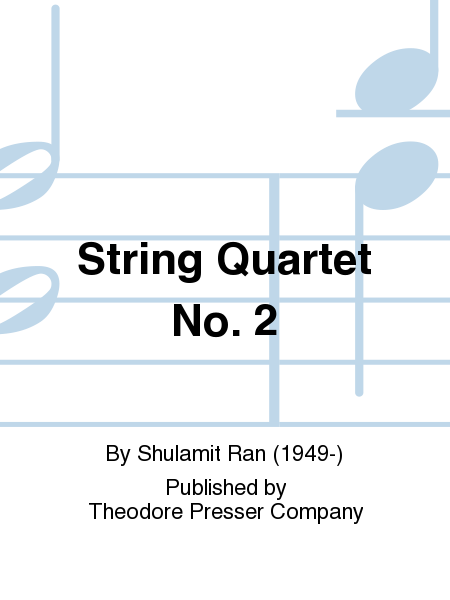String Quartet No. 2
Vistas
-
Ships in 2 to 3 weeks
Details
Description
SKU: PR.11440698S
Vistas. Composed by Shulamit Ran. Spiral. Full score. With Standard notation. 44 pages. Duration 25 minutes. Theodore Presser Company #114-40698S. Published by Theodore Presser Company (PR.11440698S).UPC: 680160010820. 11 x 14 inches.
Shulamit Ran’s second string quartet, subtitled “Vistas,” occupies a large canvas that is cast in a traditional fourmovement mold, where the outer movements present, explore, and later return to the work’s principal musical materials, surrounding a slow movement and scherzo-type third movement with a trio. In addition to tempo-based titles, the individual movements have subtitles that are evocative of each movement’s character, as follows: I. Concentric: from the inside out II. Stasis III. Flashes IV. Vistas.
My second string quartet, “Vistas”, is a work cast in a traditional four-movement formal mold, with the outer movements, presenting and later returning to the work’s principal musical materials, surrounding a slow movement and a scherzo-type third movement.While the four movements’ “proper” names -- Maestoso con forza, Lento, Scherzo impetuoso, and Introduzione; Maestoso e grande – give some indication of the general character of the individual movements, I have also subtitled, less formally, each movement as follows: 1) Concentric: from the inside out 2) Stasis 3) Flashes 4) Vista. The images evoked by these titles tell one, I think, a bit more about the inner workings of the quartet.In the first movement, a prominently presented opening pitch (E) reveals itself, as the movement unfolds, to be a center of gravity from which ever-growing cycles of activity gradually evolve. While various important themes come into being as the movement progresses, their impact on the listener has, I believe, a great deal to do with their juxtaposition and relationship to the initial central point of gravity.Stasis is, as the name implies, a movement where activity seems, at times, almost suspended. Being also, as Webster’s Dictionary reminds us, “a state of static balance and equilibrium among opposing tendencies or forces,” it develops various materials, including ones from the first movement, without bringing them to points of resolution.Flashes is short and very fast, evoking in my mind the quick shimmer of fireflies, a “sudden burst of light”, but also a “brief time”. Perhaps, even, a “smile”?Finally, the last movement, Vista, is not only “a view or outlook”, but also “a comprehensive mental view of a series of remembered or anticipated events.” After a brief recall of the opening of the second movement, this movement brings back all the important themes of the first movement in their original order. But just as going back can never really mean going back in time, the movement is much more than recapitulatory. By cutting through previously transitory passages and presenting the main ideas in a fashion more direct yet more evolved, it also sheds new light on earlier events, offering a retrospective, synoptic view of the first movement as it brings to culmination the work as a whole. “Vistas” was commissioned by C. Geraldine Freund for the Taneyev String Quartet of what was then Leningrad. It was the first commission given in this country to a Soviet chamber ensemble since the 1985 cultural exchange accord between the Soviet Union and the United States.

 Share
Share